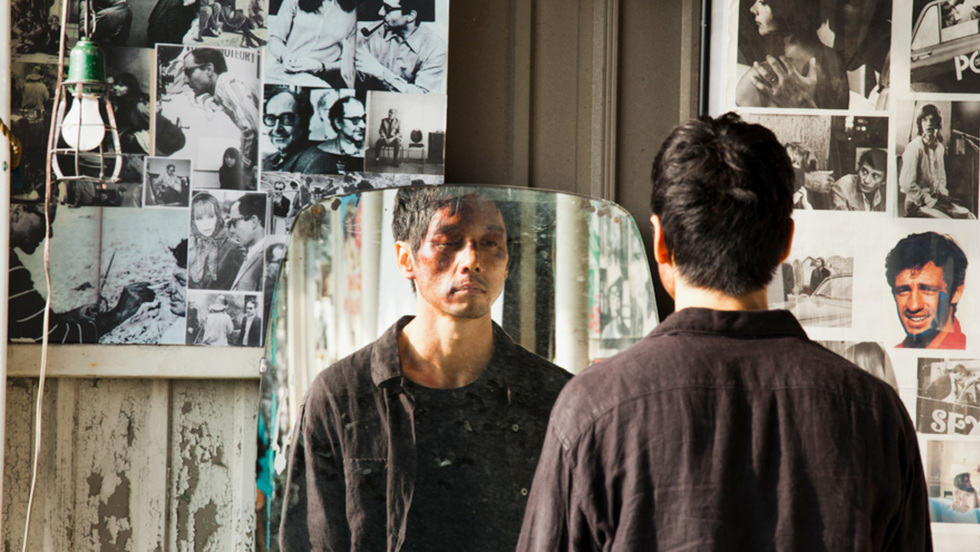
BY KAREN KEMMERLE |
A Punch to the Face for Cinephiles
Iranian director Amir Naderi returns to TFF with Cut, about a Japanese filmmaker who is willing to take a beating from the Yakuza to fund his movie. Now that's commitment.

Tribeca: Tell us a little about Cut. How would you describe the movie in your own words?
Amir Naderi: The film is made for the cinephile and filmmaker. It is a very different film for me to bring to American audiences because it’s from another country, another planet, another language, and another culture—Japan. Cut was very successful in Japan. It showed at the cinemas for four straight months.
In the back of my mind, I always intended to bring this film to New York where I have lived for the past 20 years. Originally, we were supposed to make Cut in the U.S. and in English, but the current problem with cinema in this country is that so many talented filmmakers have nowhere to show their work. In Japan, I was able to make the movie and know that Japanese audiences would see it. However, cinema is an international language no matter where the film is made; whether you are in London or Romania, cinema is cinema.
I hope Tribeca audiences will have an open mind when they see Cut and that they care about pure cinema. Of course, entertainment is important too, but this is a film about the nature of cinema itself.
TRIBECA: The main character of CUT, Shuji, has some very interesting lines about cinema, both past and present. Do his views reflect your own?
AMIR NADERI: Yes. Cinema today owes everything to the masters of yesterday. It’s now very easy to see movies, whether in the theaters or on DVD, and I hope that viewers appreciate and respect this privilege. Unfortunately, many of the latest releases rely on special effects rather than characters, and, as a result, mainstream cinema is in a miserable state. There are theaters that are devoted to independent films and classic films, though they are dwindling in New York City.
I hope people take advantage of the few that are left and see films like SINGIN’ IN THE RAIN. That movie has everything: art, entertainment, music and more. You can enjoy the film because it’s so rich, and you think about it long after it’s over and share it with others. Today audiences are brainwashed with high-budget spectacles, and they have lost sight of the filmmakers that truly matter. I’m worried that in 20 years, no one will know or appreciate Howard Hawks.

Tribeca: What is it that drew you to Japan? As a director working in a foreign land, did you find it difficult to work with a Japanese cast and crew? Was the experience different from working with a cast and crew from your own country?
AMIR NADERI: Well, for the past 20 years, I have been teaching the golden age of Japanese cinema, whether I’m in Japan or not. I love the use of black and white film, the editing techniques, and all those master filmmakers. I don’t really focus on film history or cinema theory. I’m a practical teacher. I’ve had experience in film, so I can teach students how to emulate these master filmmakers. I always knew I wanted to make a movie about Japan, but in Japan too the special effect movies are taking over.
To be honest, I really worked to make a John Cassavetes movie for Japanese audiences. For me, he’s the Mozart of modern cinema. After he died, I thought somebody should do something. However, if I made the film about Cassavetes, the film would have been very dark, and I didn’t want my character to be dark. The way Cassavetes worked was almost suicidal. My film is basically about the last samurai trying to save cinema but sacrificing himself for its sake.
All these ideas came from Cassavetes’ life. John was a master, and this film is dedicated to him, even though I made it in Japan. It’s a film about Japanese filmmakers, but his presence is everywhere. His mind and his filmmaking skills are international.
Tribeca: What were the challenges you faced writing a film set in Japan?
AMIR NADERI: It is difficult to make a movie in Japan, especially for foreigners. It’s a very complicated and wonderful culture. They know exactly who they are and want they want, and they do not easily accept people who want to come over and make art in their country. If you respect them and are patient, things work out, but trust still takes a lot of time. Trust is the most important thing to the Japanese people.
I should add that improvising in Japanese cinema is impossible. When you come to set, you have to have everything laid out and ready to go from 8AM to 6PM, and everything must be concrete. It took me a while to adapt to this process, but once the trust was established, it was much easier. I believe the crew I worked with in Japan was one of the finest I’ve ever worked with. If you treat everyone with respect, everything will run smoothly. Friendship comes soon after. I really enjoyed my experience.
TRIBECA: One of my favorite sequences in the film was your “100 punches, 100 films” sequence. I loved the pacing of it. If it had been any other director, let’s say Guy Ritchie, it would have been all effects and quick edits.
AMIR NADERI: This film is about cinema, so I wanted to make it as cinematic as possible. I made this film for two reasons: for the editing and sound design. I wanted to use sound as a character, as dialogue in my own symphony. I always edit my own films, and this one owes much to the masters of Japanese cinema like Ozu and Kurosawa. For sound, I paid homage to Kubrick and Fellini and John Ford. There are so many influences in this film, though I made it my own. Rhythm is particularly important in this film because there is not much dialogue. It came from a passion to keep going and fight for anything you want. My message to filmmakers is that they should perservere until they get what they want. That’s a very Japanese theme.
For the rhythm in the film, I choreographed everything very carefully. Violence is not just violence; it is almost like dancing. I planned the body language of the actors very carefully; we thought very carefully about each punch and each kick to make sure they all flowed together. It was very hard and risky.

Tribeca: How did you choose the films to highlight?
AMIR NADERI: Well, my life is cinema. I think everyone has their own 100 greatest film lists. For me, it was important to use films that are at least 25 years old. I may have put one or two films in from the early 90s, but that’s it. I combined my tastes with Shinji’s character, which was easy since that character is based on myself. All my films are about my own experiences. Cut is about Cassavetes, but it’s also about me.
Each film featured in the sequenced helped moved cinema forward, if only just a little bit. That’s the point. The more original the film, the better I like it.
Tribeca: What's your advice for aspiring filmmakers?
AMIR NADERI: Filmmakers need to revisit cinema from the past. Those films need an audience. Please take care of the cinema of the past, or these films will be lost. We have to respect the past. I am worried that in 20 years, no one will have heard of Luis Buñuel.
Filmmakers should experience something and then try to share their experiences through film. If this relationship between the artists and their audiences gets lost, then what? I can’t imagine.
Tribeca: What are you most looking forward to at Tribeca?
AMIR NADERI: I want my film to be a wake up call. Don’t forget the films of the past. They are treasure. If you want gold, it’s already there. Go look into the films of Stroheim, of Preston Sturges. If you want a comedy, watch a Preston Sturges movie. That’s what a comedy is. There is nothing new today. They did everything so honestly. Cinema needs help. I feel it. If we introduce classic cinema to new generations, there might be hope.
Tribeca: If you could have dinner with any filmmaker (alive or dead), who would it be?
AMIR NADERI: Stroheim. Erich von Stroheim. Cinema owes him a lot.
Tribeca: What’s your favorite New York movie?
AMIR NADERI: Of course, this is very difficult. I think it has to be Taxi Driver in the modern cinema. There are so many great films of the past. It’s one of the most interesting films about New York.
I also love The Band Wagon, Sweet Smell of Success and On the Town. Those movies are dreams of New York.
Tribeca: What would your biopic be called?
AMIR NADERI: Cut.
AMIR NADERI: What makes CUT a Tribeca must-see?
AMIR NADERI: This film is from the other side of the world, but the message is universal. I want people to get excited about watching old cinema and movies from the past. Don’t look at the past as nostalgic, but as a treasure. Today films do not have character; they sell the cliché. I wish people cared about cinema of the past. Please take care of cinema before it dies.
 Amir Naderi has been among the most influential figures of New Iranian Cinema since the 1970s. He is the director of the classics The Runner (1985) and Water, Wind, Dust (1986). His 2005 film Sound Barrier won the Critics Prize at the Rome Film Festival, and his work has been the subject of museum retrospectives worldwide.
Amir Naderi has been among the most influential figures of New Iranian Cinema since the 1970s. He is the director of the classics The Runner (1985) and Water, Wind, Dust (1986). His 2005 film Sound Barrier won the Critics Prize at the Rome Film Festival, and his work has been the subject of museum retrospectives worldwide.